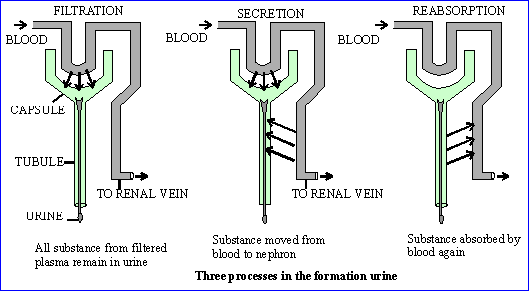|
PinkMonkey Online Study Guide-Biology
ii) Formation of Urine
The formation of urine involves three processes: ultrafiltration, reabsorption and secretion (Figure 19.6). In these processes there is movement of water (solvent) and dissolved molecules of a small size (solutes) from malpighian body into the tubular lumen under physical pressure (ultrafiltration). This forms the primary urine which is isosmotic to blood from which it is derived. Later the composition of primary urine is altered by reabsorption of useful substances (e.g. glucose) into the blood, and by the secretion of unwanted substances (e.g. urea) from the blood into the tubular fluid. Reabsorption and secretion involve active transport, therefore are physiological processes; while ultrafiltration is a physical process (filtration under pressure).
The concentration of primary urine depends upon the length of loop of Henle. Animals with a longer loop (eg. beaver) produce dilute urine, while man, rabbit have both short and long loops in kidney and have intermediate ability to concentrate urine.
 Click here to enlarge
Click here to enlarge
a) Ultrafiltration (Glomerular filtration)
The afferent vessel, which is of a larger diameter than
the efferent vessel, brings the blood into the glomerulus. Here, the endothelial
cells of blood vessels, the basement membrane and the single cell
lining of the Bowmanís capsule form a semipermeable membrane. The blood
entering the glomerulus is filtered through the semipermeable membrane
into the lumen of the Bowmanís capsule under pressure. This filtration
under pressure is called ultrafiltration. Blood pressure in glomerular
capillaries is about 70 mm Hg. Opposing this is osmotic pressure of blood
plasma proteins, which is about 32 mm Hg. Added to this is the pressure
of fluid in the nephric capsule, about 20 mm Hg. Therefore the effective
filtration pressure is 70- (32+20), i.e. about 18 mm Hg. The glomerular
filtrate is nearly isosmotic to plasma and has the same composition
of blood, except it does not contain blood cells and proteins. This glomerular
filtrate is also called deprotenized plama or primary urine.
[next page]
|
Table of Contents
19.0 -
Introduction
19.1 -
Ammonotelism, Ureotelism and Uricotelism
19.2 -
Excretory System of Man
19.3 -
Skin and Lungs as Accessory Excretory Organs
Chapter
20
|